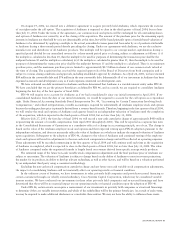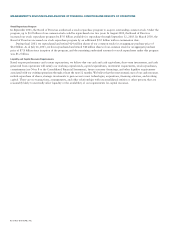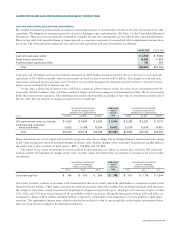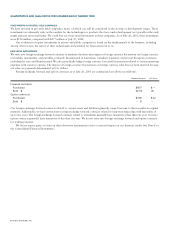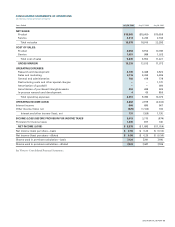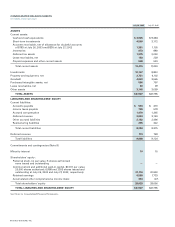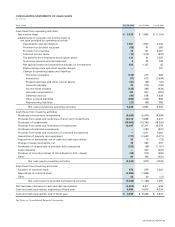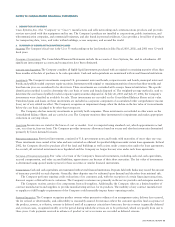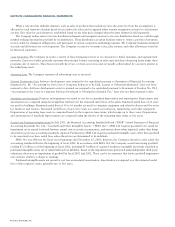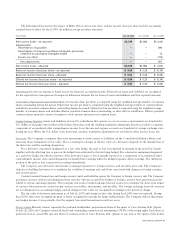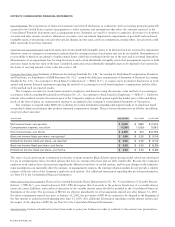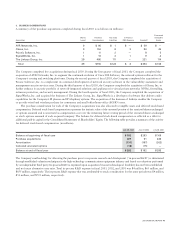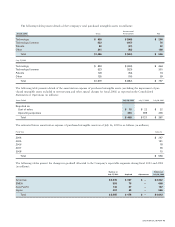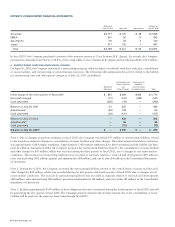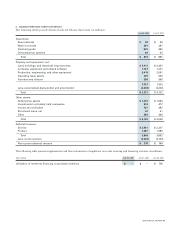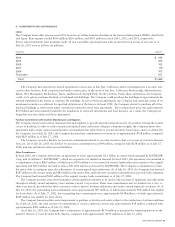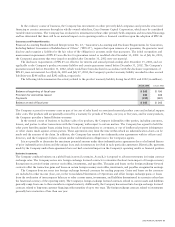Cisco 2003 Annual Report Download - page 43
Download and view the complete annual report
Please find page 43 of the 2003 Cisco annual report below. You can navigate through the pages in the report by either clicking on the pages listed below, or by using the keyword search tool below to find specific information within the annual report.
The following table presents the impact of SFAS 142 on net income (loss) and net income (loss) per share had the accounting
standard been in effect for fiscal 2001 (in millions, except per-share amounts):
Years Ended July 26, 2003 July 27, 2002 July 28, 2001
Net income (loss)—as reported $3,578 $1,893 $(1,014)
Adjustments:
Amortization of goodwill —— 690
Amortization of acquired workforce intangible previously
classified as purchased intangible assets ——13
Income tax effect —— (102)
Net adjustments ——601
Net income (loss)—adjusted $3,578 $1,893 $ (413)
Basic net income (loss) per share—as reported $0.50 $0.26 $ (0.14)
Basic net income (loss) per share—adjusted $0.50 $0.26 $ (0.06)
Diluted net income (loss) per share—as reported $0.50 $0.25 $ (0.14)
Diluted net income (loss) per share—adjusted $0.50 $0.25 $ (0.06)
Income Taxes Income tax expense is based on pre-tax financial accounting income. Deferred tax assets and liabilities are recognized
for the expected tax consequences of temporary differences between the tax bases of assets and liabilities and their reported amounts.
Computation of Net Income (Loss) per Share Basic net income (loss) per share is computed using the weighted-average number of common
shares outstanding during the period. Diluted net income per share is computed using the weighted-average number of common shares
and dilutive potential common shares outstanding during the period. Diluted net loss per share is computed using the weighted-average
number of common shares and excludes dilutive potential common shares outstanding, as their effect is antidilutive. Dilutive potential
common shares primarily consist of employee stock options and restricted common stock.
Foreign Currency Translation Assets and liabilities of non-U.S. subsidiaries that operate in a local currency environment are translated to
U.S. dollars at exchange rates in effect at the balance sheet date, with the resulting translation adjustments directly recorded to a separate
component of accumulated other comprehensive income (loss). Income and expense accounts are translated at average exchange rates
during the year. Where the U.S. dollar is the functional currency, translation adjustments are recorded in other income (loss), net.
Derivatives The Company recognizes derivative instruments as either assets or liabilities on the Consolidated Balance Sheets and
measures those instruments at fair value. The accounting for changes in the fair value of a derivative depends on the intended use of
the derivative and the resulting designation.
For a derivative instrument designated as a fair value hedge, the gain or loss is recognized in earnings in the period of change
together with the offsetting loss or gain on the hedged item attributed to the risk being hedged. For a derivative instrument designated
as a cash flow hedge, the effective portion of the derivative’s gain or loss is initially reported as a component of accumulated other
comprehensive income (loss) and subsequently reclassified into earnings when the hedged exposure affects earnings. The ineffective
portion of the gain or loss is reported in earnings immediately.
The Company uses derivative instruments to manage exposures to foreign currency and securities price risk. The Company’s
objective in holding derivatives is to minimize the volatility of earnings and cash flows associated with changes in foreign currency
and security prices.
Certain forecasted transactions and foreign currency assets and liabilities expose the Company to foreign currency risk. The Company
purchases currency options and designates these currency options as cash flow hedges of foreign currency forecasted transactions
related to certain operating expenses. The Company enters into foreign exchange forward contracts to minimize the short-term impact
of currency fluctuations on certain foreign currency receivables, investments, and payables. The foreign exchange forward contracts
are not designated as accounting hedges, and all changes in fair value are recognized in earnings in the period of change.
The fair value of derivative instruments as of July 26, 2003 and changes in fair value during fiscal 2003 were not material. During
fiscal 2003, there were no significant gains or losses recognized in earnings for hedge ineffectiveness. The Company did not discontinue
any hedges because it was probable that the original forecasted transactions would not occur.
Minority Interest Minority interest represents the preferred stockholders’ proportionate share of the equity of Cisco Systems, K.K. (Japan).
At July 26, 2003, the Company owned all issued and outstanding common stock amounting to 94.8% of the voting rights. Each share of
preferred stock is convertible into one share of common stock of Cisco Systems, K.K. (Japan) at any time at the option of the holder.
2003 ANNUAL REPORT 41


